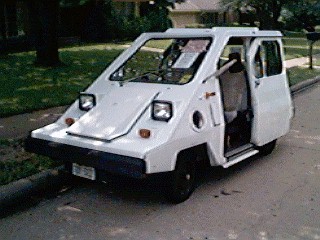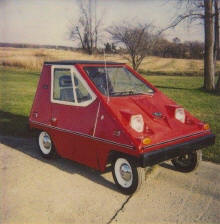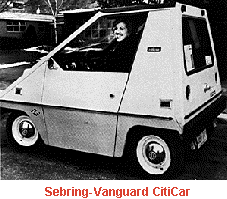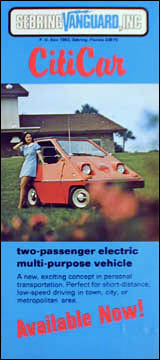Sebring-Vanguard, Inc. - Citicar
 Citivan The CitiCar was produced between 1974 and 1977 by a U.S. company called Sebring-Vanguard, Inc., based in Florida. The CitiCar and variants are the most produced electric car in American automobile history. Sebring-Vanguard was sold to Commuter Vehicles, Inc Commuter Vehicles, Inc. produced similar vehicles (the Comuta-Car and Comuta-Van) from 1979 to 1982. HistoryThe CitiCar was a small electric vehicle, first produced in Florida in 1974 by a company called Sebring-Vanguard partly in response to the mid-1970s fuel crisis. The CitiCar was a tiny golf cart sized car that could go at a top speed of about 39 mph (63 km/h). Early versions had no extra features such as locking doors or air conditioning. In 1976, enough CitiCars were produced to promote Sebring-Vanguard to the position of being the U.S. #6 auto manufacturer after GM, Ford, Chrysler, AMC, and Checker (Taxis...) Production of the CitiCar continued until 1977 with about 2,300 CitiCars produced. Commuter Vehicles, Inc. purchased the CitiCar design, and renamed the vehicle Comuta-Car. Production of an upgraded version began in 1979 and Commuter Vehicles, Inc. produced an estimated 2,000 Comuta-Cars and Comuta-Vans. At about 4,300 C-Car variants produced, it still holds the record for most road-legal electric cars made in automobile history.
ModelsThe CitiCar came in three models. The original Coupe was the smallest
of the three. It had a flat diagonal front, a flat roof, and a flat
nearly vertical back. Early coupes had a 2.5 HP motor and 36v battery
pack. Later coupes had a 3.5 HP motor and 48v battery pack, and numerous
small
From Wikipedia, the free encyclopedia: Text is available under the Creative Commons Attribution-ShareAlike License; additional terms may apply. See Terms of Use for details. |
||||||||||||||||||||||||||



 improvements. The later Comuta-Car model had a larger 6 HP motor,
and moved the batteries from under the seat to the bumpers, making the
vehicle about 16 inches (410 mm) longer than the 8-foot (2.4 m) long
CitiCar. The largest of the three was called the CitiVan, or Comuta-Van.
The overall length was increased to 142 inches (3,600 mm), and it had a
12 HP motor, 72v battery pack, and 3-speed transmission. It still held
two passengers, but also had room for storage. It was the only model
with a trunk and sliding door. Many Comuta-Vans were built with
right-hand-drive for the US Postal Service. All vehicles were built with
welded aluminum pipe space frames and ABS plastic bodies, with solid
axles and leaf spring suspension front and rear. Top speeds were about
30-50 mph, and range was up to 40 miles per charge.
improvements. The later Comuta-Car model had a larger 6 HP motor,
and moved the batteries from under the seat to the bumpers, making the
vehicle about 16 inches (410 mm) longer than the 8-foot (2.4 m) long
CitiCar. The largest of the three was called the CitiVan, or Comuta-Van.
The overall length was increased to 142 inches (3,600 mm), and it had a
12 HP motor, 72v battery pack, and 3-speed transmission. It still held
two passengers, but also had room for storage. It was the only model
with a trunk and sliding door. Many Comuta-Vans were built with
right-hand-drive for the US Postal Service. All vehicles were built with
welded aluminum pipe space frames and ABS plastic bodies, with solid
axles and leaf spring suspension front and rear. Top speeds were about
30-50 mph, and range was up to 40 miles per charge.